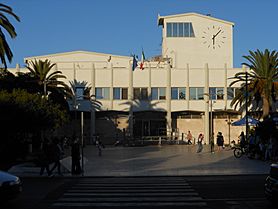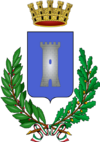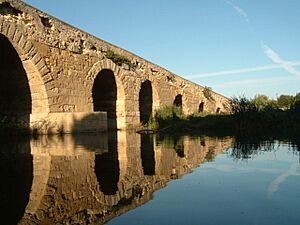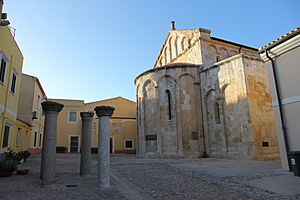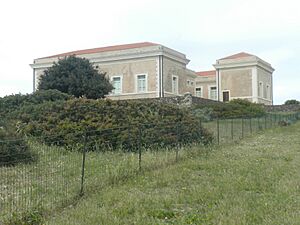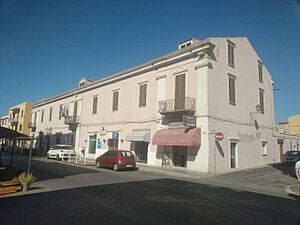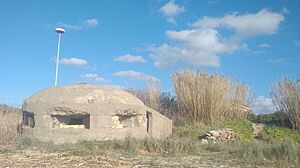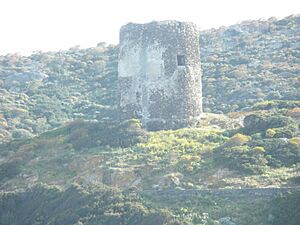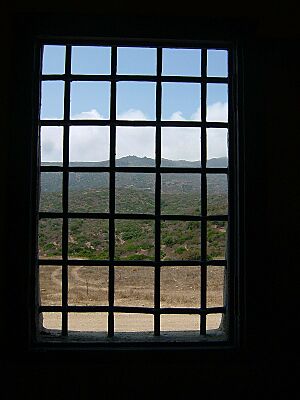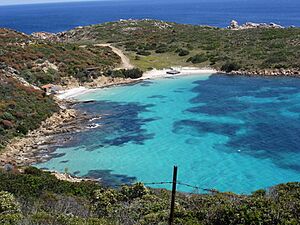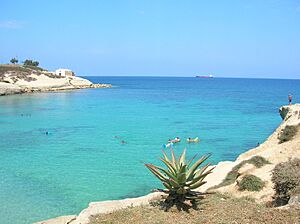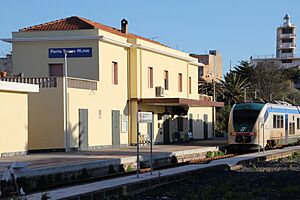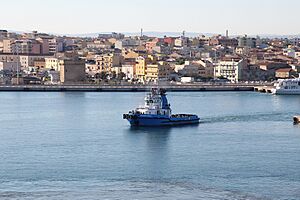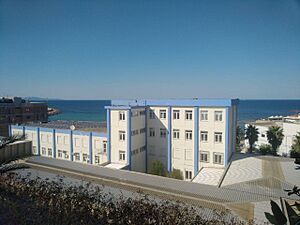Porto Torres facts for kids
Quick facts for kids
Porto Torres
Posthudòrra (Sassarese)
|
||
|---|---|---|
| Città di Porto Torres | ||
|
|
||
|
||
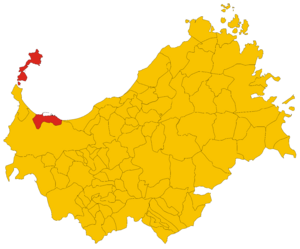
The territory of the comune (in red) inside the Province of Sassari
|
||
| Country | Italy | |
| Region | Sardinia | |
| Province | Sassari (SS) | |
| Founded | 46 b.C (Roman settlement) 11 June 1842 (comune) |
|
| Frazioni | Li Lioni, Asinara, Fiume Santo, Platamona | |
| Area | ||
| • Total | 104.41 km2 (40.31 sq mi) | |
| Elevation | 17.00 m (55.77 ft) | |
| Population
(31 January 2020)
|
||
| • Total | 22,134 | |
| • Density | 211.991/km2 (549.05/sq mi) | |
| Demonym(s) | Turritani, Bainzini or Portotorresi | |
| Time zone | UTC+1 (CET) | |
| • Summer (DST) | UTC+2 (CEST) | |
| Postal code |
07046
|
|
| Dialing code | 079 | |
| Patron saint | St. Gavinus, St. Proto, St. Gianuario | |
| Saint day | 30 May | |
Porto Torres (Sassarese: Posthudorra; Sardinian: Portu Turre) is a city and a comune (municipality) in the northwest of Sardinia, Italy. It was founded around 46 BC by the Romans as Colonia Iulia Turris Libisonis. This made it the first Roman colony on the entire island.
The city is located on the coast, about 25 kilometers (15 miles) east of Falcone Cape. It sits in the middle of the Gulf of Asinara. Porto Torres has the second-largest seaport on the island, after Olbia. The town is also very close to Sassari, where the local university is located.
Contents
What's in a Name?

The city's original Latin name was "Colonia Iulia Turris Libisonis". "Colonia" meant a Roman settlement. "Iulia" came from a Roman family name. "Turris" means "tower," possibly referring to an ancient nuraghe or the Monte d'Accoddi. "Libisonis" might have come from "Libya," referring to a Phoenician trading post in the area.
After the fall of the Western Roman Empire, the town was simply called "Turris." In the Middle Ages, it became "Torres." During the time of Aragonese rule, it was known as "Lo Port" (The port) in Catalan. Later, under the Savoy reign, it was called Portotorre (Porto+Torre, meaning "Towerport").
Until the 1960s, people commonly called the town "Portotorres." After it officially became a city, its name changed to Porto Torres.
A Look Back in Time
Ancient Times
The Miocene Era
In 1994, many animal fossils were found in the Fiume Santo area. These fossils are thought to be from the Miocene period, about 8 to 9 million years ago. Even remains of an ancient ape, Oreopithecus bambolii, were discovered there. This happened by chance when hobby paleontologists noticed fossils after some work at a nearby power station.
Scientists found 15 different vertebrate species, including giraffes, crocodiles, turtles, and wild pigs. Most of these animals were plant-eaters, but some, like the Indarctos anthracitis, ate both plants and meat.
Early Human History
Evidence of early human life in Porto Torres comes from many ancient burial sites, called necropolis. The altar of Monte d'Accoddi, very close to the town, also shows that people lived in this area a very long time ago.
Bronze and Nuragic Ages
Discoveries from these periods were made at the Necropolis of Su Crucifissu Mannu. Two skulls found there showed signs of surgical procedures. These might have been done to treat problems like migraines or tumors. Another idea is that these surgeries were for religious or magical reasons.
Many nuraghes, which are ancient stone towers, also date from this time. Today, seven of these structures are still well-preserved. The Domus de Janas of Andreolu also proves the presence of the Nuragic civilization.
Roman Period (46 BC – 455 AD)
In ancient times, Turris Libisonis was one of Sardinia's most important cities. It was likely founded by Julius Caesar as a Roman settlement, called Colonia Julia. Pliny described it as the only Roman colony on the island at that time. This suggests there was only a fort there before the city was built.
Ancient ruins show it was a large town under the Roman Empire. Old milestones tell us that the main road on the island went from Caralis (Cagliari) directly to Turris. This shows it was a very busy place. There are still remains of a temple, baths, a large public building (basilica), and an aqueduct. A bridge over the nearby river, called Fiume Turritano, also still stands.
After the Roman Empire
The ancient city remained active until the 11th century. Then, most people moved to Sassari, about 15 kilometers (9 miles) inland and on a hill. Porto Torres was partly controlled by Genoa until the early 15th century. Then, the Aragonese took control. After a period of Spanish rule, it became part of the Kingdom of Sardinia.
Porto Torres became a separate comune (municipality) from Sassari in 1842. The area around the Basilica of Saint Gavino joined with the fishing community near the port to form the new Porto Torres. On May 10, 1942, Benito Mussolini visited the town. On April 18, 1943, the city experienced air raids by the Allies.
Geography
Porto Torres is located on the northwest coast of Sardinia.
The municipality covers almost 10,200 hectares (about 39 square miles). It is divided into two nearly equal parts. One part includes the city, its industrial area, and Roman ruins. The other part consists of two islands: Asinara and the smaller Isola Piana. Since 1997, this island area has been the Asinara National Park.
The "city part" of the municipality is mostly flat. The area around Porto Torres and northwest Sardinia is known for the Nurra plain. There are some hills in the middle of this plain. Part of these hills are in Porto Torres, with Monte Alvaro being the highest point at 342 meters (1,122 feet) above sea level.
Two rivers flow through the area: Rio Mannu and Fiume Santo. Rio Mannu flows along the western edge of Porto Torres. Fiume Santo runs near the city and was used for boats as far back as ancient Rome.
Climate
| Climate data for Porto Torres (1981-2010) | |||||||||||||
|---|---|---|---|---|---|---|---|---|---|---|---|---|---|
| Month | Jan | Feb | Mar | Apr | May | Jun | Jul | Aug | Sep | Oct | Nov | Dec | Year |
| Mean daily maximum °C (°F) | 13.6 (56.5) |
14.0 (57.2) |
16.2 (61.2) |
18.5 (65.3) |
23.1 (73.6) |
27.2 (81.0) |
30.3 (86.5) |
30.8 (87.4) |
26.8 (80.2) |
22.8 (73.0) |
17.7 (63.9) |
14.2 (57.6) |
21.3 (70.3) |
| Mean daily minimum °C (°F) | 5.1 (41.2) |
5.0 (41.0) |
6.7 (44.1) |
8.4 (47.1) |
12.0 (53.6) |
16.0 (60.8) |
18.7 (65.7) |
19.5 (67.1) |
16.5 (61.7) |
13.2 (55.8) |
9.5 (49.1) |
6.7 (44.1) |
11.4 (52.5) |
| Average precipitation mm (inches) | 44.5 (1.75) |
37.3 (1.47) |
41.8 (1.65) |
47.6 (1.87) |
33.3 (1.31) |
13.6 (0.54) |
3.3 (0.13) |
9.8 (0.39) |
42.6 (1.68) |
82.9 (3.26) |
89.4 (3.52) |
65.9 (2.59) |
511.9 (20.15) |
| Source: Climatologia della Sardegna per il trentennio 1981-2010 | |||||||||||||
Population
Until the 1960s, Porto Torres was like a large village. Then, its population grew quickly because of new industries. This growth continued until the 1980s. At that time, the local petrochemical industry faced big financial problems.
| Historical population | ||
|---|---|---|
| Year | Pop. | ±% |
| 1861 | 2,025 | — |
| 1871 | 2,248 | +11.0% |
| 1881 | 3,228 | +43.6% |
| 1901 | 4,225 | +30.9% |
| 1911 | 5,154 | +22.0% |
| 1921 | 5,792 | +12.4% |
| 1931 | 7,116 | +22.9% |
| 1941 | 7,311 | +2.7% |
| 1951 | 9,118 | +24.7% |
| 1961 | 11,199 | +22.8% |
| 1971 | 16,230 | +44.9% |
| 1981 | 21,990 | +35.5% |
| 1991 | 21,264 | −3.3% |
| 2001 | 21,064 | −0.9% |
| 2011 | 22,391 | +6.3% |
| Source: ISTAT | ||
People from Other Countries
In 2019, Porto Torres had 599 residents from other countries. Many of them came from Africa and Eastern Europe. The main nationalities included:
- Nigeria: 61
- Romania: 56
- Serbia: 45
- Senegal: 34
- Poland: 32
- Ghana: 29
- Somalia: 24
- Ivory Coast: 22
- China: 20
- Mali: 17
- Other: 159
Economy
Tourism
Since 2008, tourism has become very important for the city's economy. Porto Torres has many interesting places, both natural and man-made. The main attraction is the Asinara National Park. The old Aragonese seaport tower is a symbol of the city and a popular tourist spot.
Other key attractions include the Roman bridge of Riu Mannu and the Basilica of Saint Gavinus. As the traditional industrial sector has declined, tourism has grown to be a leading part of the local economy.
Industry
Chemical industries are a big part of Porto Torres's modern economy. Fiume Santo, a large power station owned by E.ON, is about 5 to 10 kilometers (3 to 6 miles) west of the city.
Plans are underway in Porto Torres to change from old industries to new ones. Seven research centers are working to transform traditional fossil fuel industries. They aim to create a production chain that uses vegetable oil from seeds to make bioplastics.
Other Activities
Fishing and farming are also important activities in the land around Porto Torres.
How the City is Run
| In charge | Name | Political alliance | Role | Notes |
|---|---|---|---|---|
| 20 July 1988 24 June 1990 |
Rodolfo Cermelli | Christian Democracy | Mayor | |
| 27 July 1990 28 June 1993 |
Giacomo Rum | Italian Socialist Party | Mayor | |
| 28 June 1993 12 May 1997 |
Alfredo Dessì | PRC, Democratic Party of the Left, PSd'Az | Mayor | |
| 12 May 1997 28 May 2001 |
Eugenio Cossu | PRC, Democratic Party of the Left, FdV | Mayor | |
| 28 May 2001 1 February 2005 |
Gilda Usai Cermelli | FI, AN, civic list, CCD, CDU | Mayor | |
| 23 May 2005 15 June 2010 |
Luciano Mura | Democrats of the Left, PSd'Az, DL, Italian Democratic Socialists, PCI, PRC | Mayor | |
| 15 June 2010 10 February 2015 |
Beniamino Luigi Scarpa | Many civic lists, IDV | Mayor | |
| 18 June 2015 9 November 2020 |
Sean Christian Wheeler | Five Star Movement | Mayor | |
| 9 November 2020 in charge |
Massimo Mulas | Progetto Turritano, PD, Italy in Common | Mayor |
Cities We're Friends With
Porto Torres has a "sister city" relationship with another city. This means they share cultural ties and friendly exchanges.
| Country | City | Date | Notes |
|---|---|---|---|
| Camposano | 2016 |
Culture
Festivals and Events
At the end of August, Porto Torres hosts "Suoni & Sapori" (Sounds & Flavors). This festival combines tasting local food with listening to music by local artists. "La giornata dello sport" (Sport Day) is an annual event that encourages sports for both children and adults.
The "Festival Internazionale di Musiche Polifoniche Voci d’Europa" is an annual music festival organized by the local polyphonic choir. The "Fisherman's regatta" is a competition where fishermen use only traditional early 20th-century equipment, like rowing boats, without modern tools like GPS.
Places to See
Churches
- Basilica of St. Gavinus, St. Proto and St. Gianuario (1080)
This large Romanesque church was built between 1065 and 1080. It uses strong materials like marble, porphyry, and granite. It stands on "Monte Angellu" hill, in one of the town's historic areas. The basilica honors St. Gavinus, St. Protus, and St. Gianuario, who were executed in 303 AD. Unlike most churches, it has two apses instead of a western facade and eastern apse. The crypt below holds several Roman stone coffins. It was the main cathedral for the Roman Catholic Archdiocese of Sassari until 1441.
- Church of Beata Vergine della Consolata (1826)
This Neoclassic church was built in 1826 by architect Giuseppe Cominotti. It was the main church for the historic seaport area. This area was different from the rural "Monte Angellu" neighborhood near the Basilica of St. Gavinus.
- Church of San Gavino a Mare (1850)
Also known as "Balai vicino," this church is built near Balai beach. It's believed that St. Gavinus, St. Proto, and St. Gianuario were buried here after their execution. Inside the building, you can find the three burial spots of the saints.
- Church of Santu Bainzu Ischabizzaddu
This church is also called "Balai lontano" to tell it apart from the similar San Gavino a Mare. It's built where the three saints were said to have been executed. Made of limestone, it seems to be a rebuilt version of an older structure.
- Monumental Cemetery of Cala D’Oliva
This old cemetery is on the island of Asinara. It holds the ancestors of the people who founded Stintino. These people moved from Cala d'Oliva in 1885 when a prison was set up on Asinara island, forcing them to leave their homes.
- Austro-Hungarian Chapel of St Ephysius and St Gavinus (1915)
Prisoners of war from Austria-Hungary built this chapel between 1915 and 1916 on Asinara. A Hungarian prisoner named György Nemess decorated it.
- Italian Cemetery of Campo Faro (1916)
During WWI, Asinara island was also a lazaretto (a place for people with infectious diseases) for Italian soldiers with cholera. Many soldiers died before reaching the island. To distinguish Italian soldiers' bodies from Austro-Hungarian ones, this cemetery was built in the "Campo faro" area.
- Austro-Hungarian Ossuary (1936)
An ossuary is a place where bones are stored. This one was built in 1936 by the Austrian government. It holds the remains of 7,048 Austro-Hungarian soldiers who died in the prison on Asinara during WWI. They died from diseases like typhoid fever and cholera.
Other Buildings
Porto Torres has many important buildings, both private and public. These buildings show how the city grew and changed over centuries, especially during its industrial boom in the 1960s. Many of these older industrial buildings are not fully restored or open to visitors yet.
- Marquess's Palace: A neoclassical building designed by Giuseppe Cominotti, who also built the nearby Church of the "Beata vergine della consolata".
- Seaport Museum (1872): An example of 19th-century industrial architecture. It was originally a train station and is now a museum.
- The Antiquarium Turritano Museum: A museum displaying ancient artifacts.
- Junior School E. De Amicis (1912): A historic school building still in use. It shows the typical design of Italian schools from the 19th century.
- Ferromin S.A. Industrial Complex: Built in the early 20th century, this was a major industrial site for decades.
- Porto Torres Marittima Station (1872): A late 19th-century building, it was the end point for the "Ozieri-Chilivani-Porto Torres Marittima" railway.
- "Ex-cementeria Alba" Industrial Complex (1957): Built during the industrial boom, it's an example of industrial archaeology.
- "Ex ferriera sarda" Industrial Complex (1959): Another example of industrial growth in northern Sardinia.
- Agricultural Consortium of Via Sassari: An old building that shows the city's agricultural past. Its historical storage buildings, "I Granai", are now a shopping mall.
- Hamlet of Cala d'Oliva: Located on Asinara island, this was a historic settlement abandoned in the late 19th century.
- Lighthouse of Punta Scorno (1854): On Asinara, this is an old, working lighthouse, one of the oldest in Sardinia.
- Stoplight Station of Punta Scorno.
- Royal Palace of Cala Reale: The summer home of the Savoy royal family when they visited Asinara.
- Hospital of Cala Reale.
- Healthcare Maritime Quarantine Station of Cala Reale: A building used both as a lazaretto (for isolating sick people) and for local healthcare storage.
Military Buildings
- Air-raid Shelter "Ex Caserma dei Carabinieri" (1943)
During the early part of WWII, air-raid shelters in Porto Torres were not used much. This changed in May 1943 when the city was heavily bombed. This air raid, the worst the city faced during the war, is remembered as the "Palm Sunday bombing." This shelter was left unused for a long time but has recently been restored and opened to the public.
- Air-raid Shelter "Scuole De Amicis"
Located under the E. de Amicis junior school, this shelter was used during WWII to protect people from air raids. Today, it serves as an exhibition gallery.
- Artillery Outpost of the Roman Bridge n° SR414 (1873)
This outpost, with several military structures, was used until WWII.
- Castle of the Asinara
Also known as the "Castellaccio," this is an ancient medieval castle on Asinara island. Today, the Asinara National Park uses it as a fire protection outpost.
- Spanish Towers (1323–1720)
-
- Aragonese Tower (1325)
- Tower of Abbacurrente (1571)
- Tower of the Finance (1525)
- Tower of Trabuccato (1609)
- Tower of Cala d'Oliva (1611)
- Tower of Cala d'Arena (1611)
- Asinara Prison Complex (1885)
Known as the "Italian Alcatraz," this prison became famous in Italy after a prisoner uprising on October 2, 1973. It held some of Italy's most serious prisoners. In over a hundred years, only one prisoner, Matteo Boe, successfully escaped from the island prison. During WWI and WWII, it was used to hold thousands of prisoners of war and political prisoners. The prison complex has several sections across the island:
-
- Prison Section "Bunker of Cala d'Oliva"
- Prison Section of Cala d'Oliva
- Prison Section of Fornelli
- Prison Section of Santa Maria
- Prison Section of Tumbarino
- Prison Section of Campu Perdu
- Prison Section of Campo Faro
- Prison Section of Stretti
- Prison Section of Trabuccato
- Prison Section of Case Bianche
- Prison Section of Elighe Mannu
Ancient Sites
- Nuraghes
-
- Nuraghe Biunisi
- Nuraghe Monte Elva
- Nuraghe Margone
- Nuraghe Nieddu
- "Turris Libisonis" Archaeological Park
Other Notable Spots
- Main Plazas
-
- Umberto I Plaza: The main square in Porto Torres, where the Town Hall is located.
- Plaza of the "Martiri Turritani."
Natural Areas
- Protected Areas
-
- Asinara National Park
- Marine protected area of the Asinara
- Sanctuary of the marine mammals
- Beaches
-
- Beach of Fiume Santo
- Beach of Renaredda
- Beach of the Scogliolungo
- Beach of Acque Dolci
- Beach of Balai
- Beach of the Scoglio Ricco
- Il Ponte
- Beach of Abbacurrente
- Beach of Farrizza
- Main Parks
-
- San Gavino's Park
- Robert Baden-Powell's Park
- Pinewood "La Farrizza"
Sports
Football
Main football clubs in Porto Torres include:
- Porto Torres Calcio (Serie D)
- Turris
- Polisportiva Dilettantistica Quartieri Riuniti (also known as "Quartieri Riuniti")
- Turritana
Tennis
The main tennis association is:
- A.S.D. Tennis Club Porto Torres
Basketball
Main basketball associations are:
- GSD Porto Torres
- CMB Porto Torres
- Silver Basket Porto Torres
- Balai Basket
Martial Arts and Combat Sports
Porto Torres has many boxing clubs and martial arts schools. Sports like Karate shotokan, MMA, Boxing, Jujitsu, Krav-Maga, and Self-defense are popular among some citizens.
Athletics
The main athletics association is:
- A.S.D. Atletica Leggera Porto Torres (associated with FIDAL)
Horse Riding
Below the ancient Roman bridge, Porto Torres has a riding hall. Here, the local A.S.D. Centro Ippico Equitazione Porto Torres practices horse riding.
Sports Facilities
- Sports Area "Cittadella dello Sport"
This is a large 67,000 square meter (about 16.5 acre) area offering many sports.
-
-
- Main Area (Campo sportivo comunale or Stadio comunale)
- This is a multi-purpose stadium with:
- 1 football pitch (60 x 105 meters), home to the A.C. Porto Torres
- Running track
- Shot put area
- Discus throw area
- Hammer throw area
- Javelin throw area
- Pole vault area
- High jump area
- Other Areas
- Boxing club "Alberto Mura"
- Tennis club
- 1 football pitch (105 x 603 meters)
- 1 football pitch (100 x 60 meters)
-

- Palasport "Alberto Mura"
This sports facility can hold 1,600 people. It is mainly used as an indoor basketball court.
- Skate Park
A 1,800 square meter (about 0.44 acre) skateboard park with various features like a bank ramp, square-rail, pyramid ledges, and a quarter pipe.
- Football Pitch "Angelo Occone"
A football pitch (100 x 60 meters) located near the town hall.
- Other
-
-
- Artificial Pine Forest
- Called "Pineta la Farrizza," "Pineta Abbacurrente," or "Pineta Balai lontano," it is mostly made up of stone pine trees.
- Bicycle Path
- This path starts from "Piazza eroi dell'onda" and ends in the plaza of "Balai lontano." It offers great views of the sea.
-
Getting Around
Main Roads
| Road | Connection | Type | Notes |
|---|---|---|---|
| Strada Statale 131 "Carlo Felice" | Porto Torres – Cagliari |  |
|
| Strada Provinciale 93 | Porto Torres – La Corte (SS) | ||
| Strada Provinciale 81 | Porto Torres – Platamona | ||
| Strada Provinciale 57 | Porto Torres – Palmadula (SS) | ||
| Strada Provinciale 42 "Dei due mari" | Porto Torres – Alghero | ||
| Strada Provinciale 34 | Porto Torres – Stintino | ||
| Strada Provinciale 25 | Porto Torres – Sorso |
Train Stations
A railway run by Trenitalia connects Porto Torres with Sassari and the rest of Sardinia. The town has two train stations. One is newer, built in the late 20th century, and is the main station. The other is older and more historic, built in the 19th century, and is called "Porto Torres marittima."
Seaport
The port of Porto Torres is mostly man-made and built on old Roman foundations. It is the largest harbor in northwest Sardinia. From here, you can travel to other parts of Italy, Spain, and France. Near the harbor is the Maritime Terminal (Stazione marittima). A new passenger terminal is also being built in the same area. You can also take a boat from the seaport to the island of Asinara.
- Destinations:
| Company | Route | Frequency | Notes | ||
|---|---|---|---|---|---|
| Tirrenia Grandi Navi Veloci |
Genoa | Daily (winter) / Double-daily (summer) [with Tirrenia] Three times a week [with G.N.V.] |
|||
| Corsica Ferries - Sardinia Ferries | Ajaccio Porto Vecchio Livorno Toulon |
Weekly | |||
| Grimaldi Lines | Civitavecchia | Five times a week | |||
| Barcelona | Five times a week | ||||
| La Méridionale | Marsiglia | Weekly | |||
| Propriano | Weekly | ||||
| Delcomar | Asinara | Daily (Summer and Spring) Three times a week (Winter and Autumn) |
|||
Public Transport
Porto Torres is part of the metropolitan network of northern Sardinia. This means the city is well-connected to almost all nearby towns by intercity buses run by ARST. Local bus services within the city are managed by the public transport agency A.t.p. Sassari.
Learning and Libraries
Schools
The town has many state secondary schools and several state primary schools. There is also a music school named after the Italian songwriter Fabrizio De André.
Because Porto Torres is close to Sassari, it's easy for students to travel to the University of Sassari using the intercity bus lines.
Libraries
The "Antonio Pigliaru" public library is the only one in Porto Torres.
Media
Local Newspapers
- In...città
- Il Corriere del Turritano
- La Voce Turritana
Radio Stations
- Radio del Golfo
Movies
- Bonifacio Angius – "Ovunque proteggimi" (2018)
Famous People
- Francesco Demuro
- Alessandro Frau
- Giuseppe Mura
- Andrea Parodi
- Fiorenzo Serra
See also
 In Spanish: Porto Torres para niños
In Spanish: Porto Torres para niños


